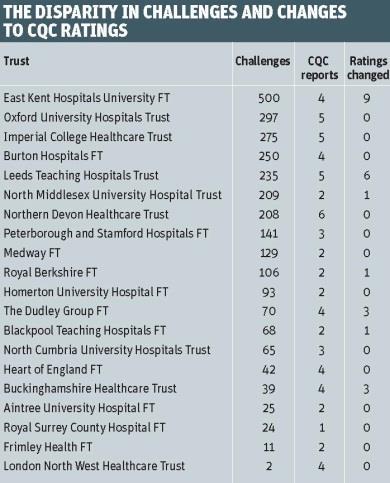There is huge variation in the number of factual accuracy challenges trusts are making to their draft Care Quality Commission inspection reports, HSJ analysis has found.
Data obtained by HSJ under the Freedom of Information Act shows that one trust challenged the accuracy of its draft reports in 500 places, whereas another made only two challenges.

The huge range in the number of challenges could indicate variation in the quality of inspection reports or big differences in the willingness of providers to contest the CQC’s findings.
HSJ submitted an FOI request to the regulator for the number of times trusts had challenged the accuracy of their draft inspection reports and the number of times these were upheld.
The CQC said the work and cost involved in gathering this data for all the trusts it had inspected would be prohibitive, so HSJ revised its request to a randomly selected sample of 20 acute trusts.
East Kent Hospitals University Foundation Trust, which was put in special measures following a critical inspection report last August, submitted more factual accuracy challenges to the regulator than any other trust in the sample.
It issued 500 challenges relating to four draft inspection reports - the individual reports for its three acute hospitals and the overall trust report.
The next highest number of challenges was from Oxford University Hospitals Trust, which received an eventual overall rating of “good” from the CQC but contested its five draft reports in 297 places. Five further trusts in HSJ’s sample issued more than 200 factual accuracy challenges to their draft reports (see table, below).
At the other end of the spectrum, London North West Healthcare Trust, which was merged with Ealing Hospital Trust in October, submitted only two challenges to its four reports. It was rated “requires improvement” by the CQC.
Frimley Health Foundation Trust, which was rated “outstanding”, only challenged its two reports in 11 areas.

The CQC said it was unable to provide data on the number of challenges “upheld” because there was no “accurate classification” of what this meant.
However, it provided information on the number of service and overall ratings that changed following challenges, which again showed significant variation between providers.
East Kent had nine of its ratings changed, although its overall “inadequate” rating stood.
Seven ratings were improved but two, relating to the overall rating for Kent and Canterbury Hospital and the hospital’s overall “well led” rating, were downgraded from “requires improvement” to “inadequate”.
Buckinghamshire Healthcare Trust submitted 39 challenges - a relatively small number - but three of its ratings were changed.
Others, such as Imperial College Healthcare Trust, which was rated “requires improvement”, did not have a single rating changed, despite making 275 challenges.
CQC chief inspector of hospitals Sir Mike Richards said allowing providers to share their views on the accuracy of reports was part of ensuring “consistency and fairness”.
“These views can range from concerns about the evidence we have used to comments on grammar and style,” he said. “As we publish provider level reports, as well as reports on the individual locations where care is being delivered, there can often be some repetition in the challenges submitted. Therefore, the total number of challenges is not a reliable reflection of the accuracy of our judgements.”
He said feedback from providers was important to ensure the CQC’s reports reflected the quality and safety of care, and could “on occasion result in changes to our ratings”.
Topics
- BUCKINGHAMSHIRE HOSPITALS NHS TRUST
- Care Quality Commission (CQC)
- EAST KENT HOSPITALS UNIVERSITY NHS FOUNDATION TRUST
- FRIMLEY HEALTH NHS FOUNDATION TRUST
- IMPERIAL COLLEGE HEALTHCARE NHS TRUST
- London North West University Healthcare NHS Trust
- Mike Richards
- Oxford University Hospitals NHS Foundation Trust
- Performance
- Regulation/inspection
- South
- South Central
CQC will miss own inspection deadlines, regulator admits
- 1
- 2
 Currently reading
Currently readingAnalysis: Huge disparity in trusts challenging CQC accuracy




























No comments yet